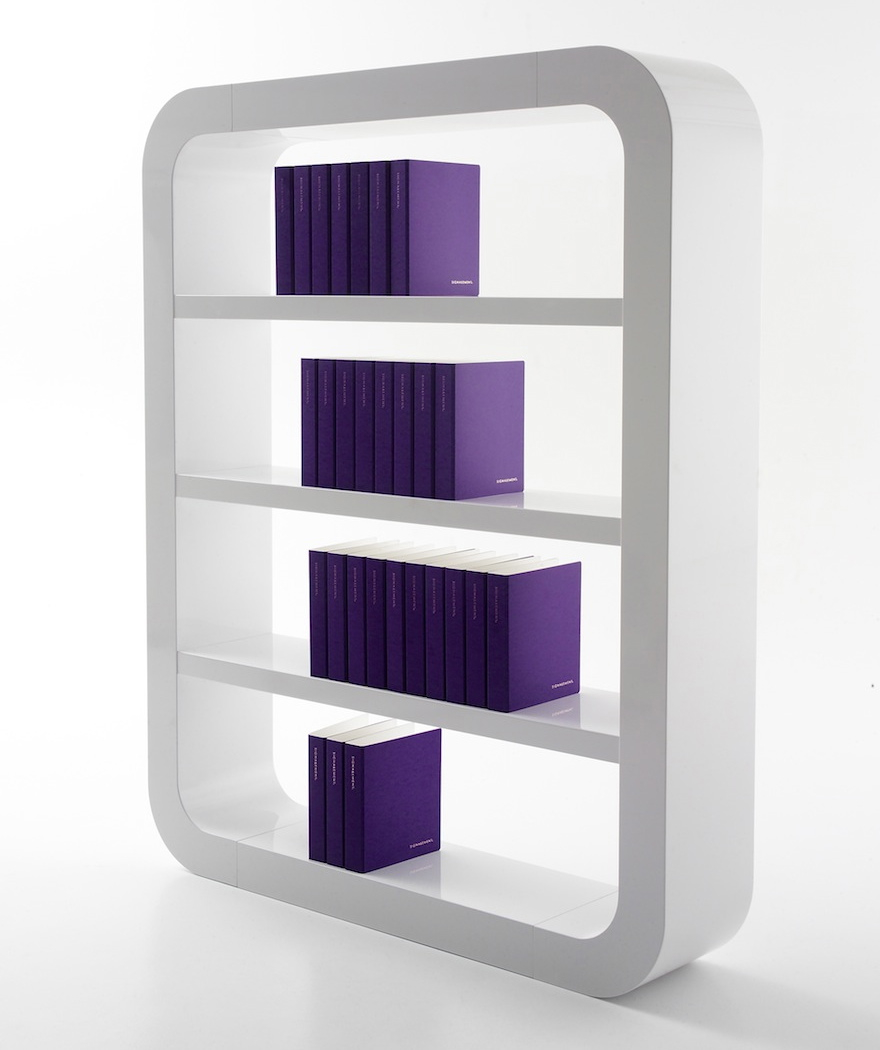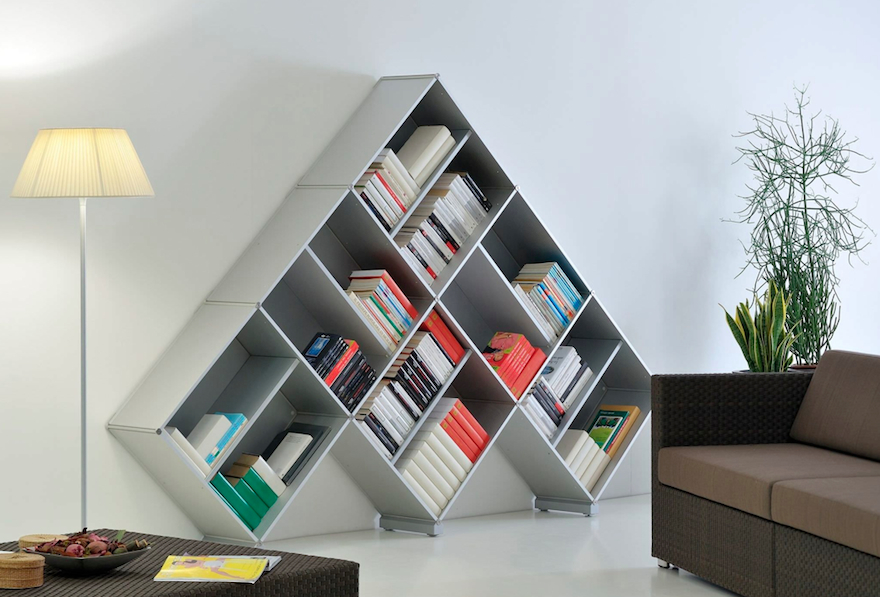Designing for Book Lovers: Bookshelves

As popular as eBooks are, good old books-on-paper are still hugely popular, too. As a professional organizer, I have many clients who love their books and have a lot of them. Which means I care a lot about bookshelves.
This shelf from Signalement has no backing to the shelves—which means that books need to be well propped up with bookends to ensure they don't fall out. However, the lack of a backing also means the shelves don't need to be positioned against a wall. End-users in places prone to earthquakes (or with small children or rambunctious pets) might be better served by shelves that are placed against a wall, so the shelves can be bolted to it. But other users might like to use shelves like this as room dividers—as long as the books going into them aren't too valuable, since books do best when not exposed to a lot of light.
The rounded edges are a nice touch, with no sharp edges to run into; feng shui practitioners will appreciate this feature. And the rounded edges only remove a tiny bit of storage space from the bottom shelf.

The Pyramid from Fitting is a modular design, which is always nice for the flexibility it provides. Bookshelves with interesting shapes don't appeal to me unless they also do a good job of storing books—and the Pyramid does indeed accommodate a lot of books. However, I'm a bit concerned about the books that are stacked horizontally on top of each other; a large stack can sometimes cause bowing to the bottom books, and those tallest stacks are about twice as high as one expert recommends.
The Pyramid is pretty easy to assemble, as demonstrated in the video above.

This modular system, called Konnex, was designed by Florian Gross. Assembly couldn't be easier, and the pieces can be assembled to accommodate both short and tall books.

Another modular system that's super-simple to assemble is the Airsquare, designed by Oliver Schick. The cubes are made from EPP (expanded polypropylene); Don Crossland explains that EPP is "the compressed foam often used in automobile and aircraft construction for its strength and lightweight durability." Each cube weighs only one kilo, but can hold about 15 kilos of books. The cubes attach with hidden knobs. Another nice design feature: There are height-adjustable metal feet to level the system on bumpy floors.

The stacked shelving system, designed by Julien De Smedt of JDS Architects for Muuto, uses boxes that are joined with steel clips—yet another way of making assembly easy. They come with or without backing.

Systems like this can fit all sorts of spaces, including under a stairway.

The Rexite Boox, designed by Alberto Basaglia and Natalia Rota Nodari, is another modular system. It's available in two depths: 13.75 inches and 17.75 inches. Deeper shelves allow for those larger books that end-users often have, but they obviously take up more floorspace, so there's always that trade-off. The Boox has optional methacrylate doors (nice for keeping books clean in dusty environments) and those doors can optionally be keyed (nice for protecting valuables from a toddler's hands). The interior shelves are made of tempered glass.

Glass-front bookcases—such as these modular bookshelves from Porada (designed by Tarcisio Colzani), or barrister bookcases from Hale—also provide protection from dust.

Bookcases can also be wall-mounted, out of reach of children's hands and pets' teeth—and the dirt that accumulates at floor level; they also provide storage when wall space is available, even if floor space isn't. As with all wall-mounted products, ease of installation (and appropriate wall surfaces) becomes a design issue. Magnetic Spirit is a modular wall-mounted option, with base panels and magnetized cubes that attach to those base panels. The base panels come with screws to attach them to a number of different wall types: concrete, full brick, limestone, sand, hollow blocks, brick, cellular concrete, gypsum board (9mm and 13mm).

The Royal System from DK3, designed in 1948 by Poul Cadovius, comes in three different depths: 24 cm, 30 cm and 60 cm. The system also allows you to adjust the height between the shelves, always a nice feature.

And for an end-user with free corner space, there's the Lorna corner shelf from the William Feeney Studio.

Some floor-mounted designs also do a nice job of accommodating end-users' space constraints. The long & low bookcase from cool-D-sign is only 70 cm high, so it would work well under a window. Low bookshelves are also good for young children, and we know that bookcases full of books are a good thing for kids.

With a 14" square base, the Sapiens bookcase (or the very similar Array bookcase) fits into narrow spaces that other bookcases wouldn't. End-users agree it's very stable (although certainly not toddler-proof), and the ones I've spoken with love these bookcases—although some others have noted that a pet brushing against them gets the books out of alignment, which can be an annoyance. With valuable books that are larger than the shelves, I'd be concerned about the books possibly bending or warping. End-users need to be aware of the capacities, too: 5.5 pounds on each shelf of the Sapien, and 9 pounds on each shelf of the Array.

Some designs don't fit our normal mental images of bookshelves. The rotating Helical Shelves from City Joinery work in corners, and also work as room dividers.

The Séverin bookcase from Alex de Rouvray Design, designed for small-format books (as well as CDs and DCDs), could also serve as a room divider.

The Murphy Door bookshelf can be flush mounted or surface mounted. End-users can add a locking system, too. It's an interesting way to create bookshelf space, and the doors hold up to 300 pounds of books.
-
oFavorite This
-
Q2Comment
K
{Welcome
Create a Core77 Account
Already have an account? Sign In
By creating a Core77 account you confirm that you accept the Terms of Use
K
Reset Password
Please enter your email and we will send an email to reset your password.


Comments
Greatest idea ever!!!